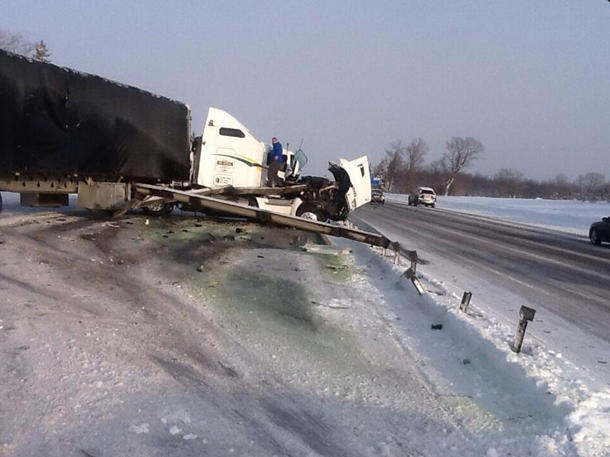
The snow squall that swept through southwestern Ontario on Thursday morning may have only dusted the region with snow as it sped along, but the 96-vehicle collision it left in its wake demonstrates one of the true dangers of this common winter phenomenon.
As many residents of southwestern Ontario know, seeing the word ‘squalls’ in the weather forecast can easily mean a rough day of snarled traffic and shoveling through knee-deep snow (or worse!). However, the amount of snow that these can deliver, sometimes in just a very narrow band, is just one of the reasons these earn their own severe weather warning from Environment Canada. Another danger from squalls is how they can quickly produce near-zero visibility with little to no warning.
This is exactly what happened on Hwy 400 north of Toronto on Thursday morning, when a snow squall blowing across southwestern Ontario plunged commuters into whiteout conditions, resulting in a massive pileup that stranded motorists on the highway for hours.
From the air, the extent of the accident was incredible.

On the ground, the frightening damage to some of the vehicles is even more apparent.



Amazingly, even with the severe damage to many of the vehicles involved in the crash, only three people were taken to hospital, thankfully with only non-life-threatening injuries.
“That’s pretty incredible,” Ontario Provincial Police Sergeant Peter Leon told the Barrie Examiner yesterday. “We’re very lucky no one was seriously injured.”
But this wasn’t the only multi-vehicle accident this snow squall played a role in.
Highway 402 between Sarnia and London was closed in both directions Thursday morning due to two separate 30-car pileups, which resulted in several injuries and one death.
Another multi-vehicle collision just east of London, near Veterans Memorial Parkway, closed the eastbound lanes of Hwy 401 yesterday morning as well. Meanwhile, further to the east, on the 401 between Woodstock and Kitchener, eight people were injured, two seriously, when an accident between two tractor-trailers and a car blocked the highway and the poor visibility resulted in another 19 vehicles getting involved in the crash.
Numerous other accidents were reported as well, mostly due to the whiteout conditions sweeping through the province.
Yesterday was just one example of the importance of weather forecasting and weather warnings.
Snow squall warnings issued by Environment Canada at the start of the day punctuated the potential serious situation, as they advised drivers caught inside whiteout conditions to immediately pull over to the side of the road and wait it out until the squall passed. The only problem was, since commuting in Ontario tends to be a lengthy process even in good weather, many of the drivers caught in these whiteouts had likely headed out on their morning commute before the warnings were issued.
It should be noted that forecasting the basic conditions for snow squalls isn’t very difficult. The winds only need to be blowing from a specific direction, so that they pick up enough moisture off the lakes to produce the heavy snowfall. However, the basic nature of snow squalls — very narrow, possibly developing very quickly and moving very quickly — makes it much more difficult to know exactly where they’ll strike ahead of time.


Leave a reply